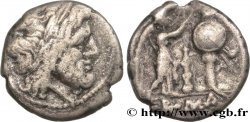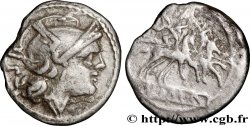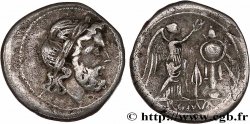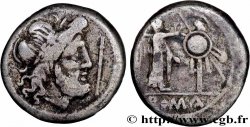v31_0109 - REPUBBLICA ROMANA - ANONIMO Sextans frappé, (MB, Æ 21)
MONNAIES 31 (2007)
Начальная цена : 195.00 €
Назначить цену : 300.00 €
Цена реализации : 283.00 €
Количество ставок : 2
Максимальная предлагаемая цена : 420.00 €
Начальная цена : 195.00 €
Назначить цену : 300.00 €
Цена реализации : 283.00 €
Количество ставок : 2
Максимальная предлагаемая цена : 420.00 €
Тип Sextans frappé, (MB, Æ 21)
Дата: c. 211-210 AC.
Монетный двор / Город: Sicile, Catane
Металл: copper
Диаметр: 20,5 mm
Ориентация осей монеты: 9 h.
Вес: 5,15 g.
Редкость: R2
Комментарии о состоянии
Magnifique exemplaire sur un flan large et irrégulier. Portrait de toute beauté avec un petit écrasement de frappe sur le pétase. Proue de qualité de frappe exceptionnelle pour ce type où tous les détails sont visibles. Très jolie patine noire lissée
Ссылки в каталоге: :
Лицевая сторона
Аверс: легенда: ANÉPIGRAPHE.
Аверс: описание: Buste drapé de Mercure à droite, coiffé du pétase ailé à droite, surmonté de deux globules.
Обратная сторона
Реверс: легенда: ROMA.
Реверс: Описание: Proue de navire à droite (rostre) ; au-dessus, un épi couché à droite.
Реверс: перевод: “Roma”, (Rome).
Комментарий
Poids léger. La marque au revers, n’est pas visible et pourrait laisser envisager une attribution à la période 214-212 avant J.-C., mais le poids de ce sextans ainsi que son module sont alors bien trop légers et petits. Nous sommes donc bien en présence d’un sextans, frappé en Sicile entre 211 et 210 avant J.-C. Bien que M. Crawford ait relevé 11 exemplaires à Paris. Ce type de monnayage frappé vraisemblablement en Sicile semble beaucoup plus rare que les émissions de l’atelier de Rome.
Light weight. The mark on the reverse is not visible and could suggest an attribution to the period 214-212 BC, but the weight of this sextan as well as its module are then much too light and small. We are therefore in the presence of a sextan, struck in Sicily between 211 and 210 BC. Although Mr. Crawford noted 11 examples in Paris. This type of coinage probably struck in Sicily seems much rarer than the issues of the Rome mint
Light weight. The mark on the reverse is not visible and could suggest an attribution to the period 214-212 BC, but the weight of this sextan as well as its module are then much too light and small. We are therefore in the presence of a sextan, struck in Sicily between 211 and 210 BC. Although Mr. Crawford noted 11 examples in Paris. This type of coinage probably struck in Sicily seems much rarer than the issues of the Rome mint








 Cообщить об ошибке
Cообщить об ошибке Распечатать страницу
Распечатать страницу Отправить мой выбор
Отправить мой выбор Задать вопрос
Задать вопрос Consign / sell
Consign / sell
 Информация
Информация









